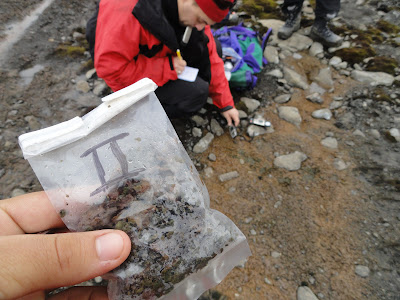Peeters K., Ertz D., Willems A. (2011) Culturable
bacterial diversity at the Princess Elisabeth Station (Utsteinen, Sør Rondane
Mountains, East Antarctica) harbours many new taxa. Systematic and Applied
Microbiology 34: 360–367. http://dx.doi.org/10.1016/j.syapm.2011.02.002
Peeters K., Verscheure S. and Willems A. (2011).
The gyrB gene is a useful phylogenetic marker for exploring the diversity of
Flavobacterium strains isolated from terrestrial and aquatic habitats in
Antarctica. FEMS Microbiology Letters 321:130-140.
Fernández-Carazo R., Namsaraev Z., Mano M.-J., Ertz
D., Wilmotte A. (2012) Cyanobacterial diversity for an anthropogenic impact
assessment in the Sør Rondane Mountains area, Antarctica. Antarctic Science 24: 229–242. (http://hdl.handle.net/2268/126310)
Ertz D., Aptroot A., Van de Vijver B., Śliwa L., Moermans C. & Øvstedal D., 2014. Lichens from the Utsteinen Nunatak (Sør Rondane
Mountains, Antarctica), with the description of one new species and the
establishment of permanent plots. Phytotaxa 191: 99-114.
Tytgat
B., Verleyen E., Obbels D., Peeters K., De Wever A., D’hondt S., De Meyer T.,
Van Criekinge W., Vyverman W. and Willems A. 2014. Bacterial
diversity assessment in Antarctic soils and lake sediments: a comparison
between bidirectional pyrosequencing and cultivation. PLoS One 9: e97564 (doi:10.1371/journal.pone.0097564).
MI Stevens, CA D’Haese. 2014. Islands
in ice: isolated populations of Cryptopygus sverdrupi (Collembola)
among nunataks in the Sør Rondane Mountains, Dronning Maud Land,
Antarctica.Biodiversity 15 (2-3), 169-177
Obbels D., E. Verleyen, M.-J. Mano, Z. Namsaraev, M. Sweetlove, B. Tytgat, R. Fernandez-Carazo, A. De Wever, S. D’hondt, D. Ertz, J. Elster, K. Sabbe, A. Willems, A. Wilmotte, and W. Vyverman. 2016. Bacterial and eukaryotic biodiversity patterns in terrestrial and aquatic habitats of the Sør Rondane Mountains, Dronning Maud Land, East Antarctica. FEMS Microbiol. Ecol. 92:fiw041. (doi: 10.1093/femsec/fiw041)
Tytgat Bjorn, Elie Verleyen, Maxime Sweetlove, Sofie D’hondt, Pia Clercx, Eric Van Ranst, Karolien Peeters, Stephen Roberts, Zorigto Namsarev, Annick Wilmotte, Wim Vyverman, Anne Willems. 2016. Bacterial community composition in relation to bedrock type and macrobiota in soils from the Sør Rondane Mountains, East Antarctica. FEMS Microbiol. Ecol. 92:fiw126 (doi: 10.1093/femsec/fiw126)
Tahon, G., B. Tytgat, A. Willems. 2016. Diversity of phototrophic genes suggests multiple bacteria may be able to exploit sunlight in exposed soils from the Sør Rondane Mountains, East-Antarctica. Frontiers in Microbiology 7:2026 (doi: 10.3389/fmicb.2016.02026)





















